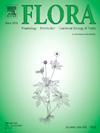紫菜营养器官的形态解剖特征及叶片组织化学和植物化学
IF 1.8
4区 生物学
Q3 ECOLOGY
引用次数: 0
摘要
在巴西、南非和世界其他地区,拉波特茶被认为是一种非传统的食用植物,具有重要的药用价值。本种原产于巴西,是该国唯一的一种。由于其营养和药用价值,以及其作为本地物种的地位,本研究旨在表征其营养器官的形态解剖学,并对其叶片进行初步的组织化学和植物化学分析。为了实现这一点,使用卡尺和立体显微镜进行宏观表征。徒手获取根、茎、叶柄、叶片的横切面和叶片的横切面,安装在载玻片上进行解剖表征。在组织化学和植物化学分析中,根据目标代谢物使用不同的试剂。宏观上看,竹属植物有茎,分枝有毛,叶片先端渐尖,基部钝,边缘有锯齿-圆齿至齿状,网状双尖状脉,花序顶端和背面有毛。解剖学上,本种有根,有侧枝维管筒;茎具四至五层角厚壁组织、厚壁组织帽和侧生维管柱;叶柄具五到六层角厚壁和双侧维管束;下气孔的叶片,具副气孔和等胞气孔;中央静脉有四至五层角状厚壁和侧支维管束。所有的营养器官都呈萎蔫状。茎、叶柄和叶片上有非腺毛,仅叶柄和叶片上有分泌通道。组织化学和植物化学测试显示,存在不同的代谢物与药理学指征在文献中引用。因此,本研究将为羊草的药理学标准化提供依据,并为其分类学、营养学和药理研究提供重要资料。本文章由计算机程序翻译,如有差异,请以英文原文为准。
Morphoanatomical characterization of vegetative organs and leaf histochemistry and phytochemistry of Laportea aestuans
In Brazil, as well as in South Africa and other regions of the world, Laportea aestuans is considered an Unconventional Food Plant and possesses significant medicinal properties. This species is native to Brazil and is the only one of its genus in the country. Due to its nutritional and medicinal importance, as well as its status as a native species, this study aims to characterize the morphoanatomy of its vegetative organs, along with a preliminary histochemical and phytochemical analysis of its leaves. To achieve this, the macroscopic characterization was performed using a caliper and a stereomicroscope. Cross-sections of the root, stem, petiole and leaf blade and paradermal sections of the leaf blade were obtained freehand and mounted on microscope slides for anatomical characterization. In histochemical and phytochemical analysis, different reagents were used according to the target metabolite. In macroscopic analysis, L. aestuans has a stem, with branches showing trichomes, leaf blade with acuminate apex, obtuse base, serrate-crenate to toothed margin, reticulate dictyodromous vein, inflorescences with the presence of trichomes on the apical and dorsal portions. Anatomically, the species presents roots with collateral vascular cylinder; stem with four to five layers of angular collenchyma, sclerenchyma caps and collateral vascular cylinder; petiole with five to six layers of angular collenchyma and bicollateral vascular bundle; hypostomatic leaf blade, with paracytic and anisocytic stomata; and central vein with angular collenchyma with four to five layers and collateral vascular bundle. All vegetative organs show drusen. There are non-glandular trichomes on the stem, petiole, and leaf blade and secretory channels only on the petiole and leaf blade. Histochemical and phytochemical tests showed the presence of different metabolites with pharmacological indications cited in the literature. Thus, this study contributes to the pharmacobotanical standardization of L. aestuans and provides important data for taxonomic, nutritional, and pharmacological studies.
求助全文
通过发布文献求助,成功后即可免费获取论文全文。
去求助
来源期刊

Flora
生物-植物科学
CiteScore
3.30
自引率
10.50%
发文量
130
审稿时长
54 days
期刊介绍:
FLORA publishes original contributions and review articles on plant structure (morphology and anatomy), plant distribution (incl. phylogeography) and plant functional ecology (ecophysiology, population ecology and population genetics, organismic interactions, community ecology, ecosystem ecology). Manuscripts (both original and review articles) on a single topic can be compiled in Special Issues, for which suggestions are welcome.
FLORA, the scientific botanical journal with the longest uninterrupted publication sequence (since 1818), considers manuscripts in the above areas which appeal a broad scientific and international readership. Manuscripts focused on floristics and vegetation science will only be considered if they exceed the pure descriptive approach and have relevance for interpreting plant morphology, distribution or ecology. Manuscripts whose content is restricted to purely systematic and nomenclature matters, to geobotanical aspects of only local interest, to pure applications in agri-, horti- or silviculture and pharmacology, and experimental studies dealing exclusively with investigations at the cellular and subcellular level will not be accepted. Manuscripts dealing with comparative and evolutionary aspects of morphology, anatomy and development are welcome.
 求助内容:
求助内容: 应助结果提醒方式:
应助结果提醒方式:


